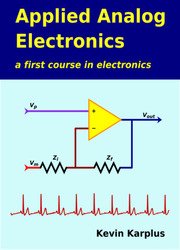Applied Analog Electronics
- Добавил: literator
- Дата: 21-06-2021, 15:46
- Комментариев: 0
 Название: Applied Analog Electronics
Название: Applied Analog ElectronicsАвтор: Kevin Karplus
Издательство: Leanpub
Год: December 28, 2020 (Edition 1.2)
Страниц: 673
Язык: английский
Формат: pdf (true)
Размер: 22.5 MB
Textbook for two-quarter course on electronics. Designed around the lab projects, not the theory. Three main concepts: voltage dividers, complex impedance, and negative-feedback amplifiers. Includes blood-pressure, optical pulse monitor, EKG, and class-D power audio amplifier, among other projects.
This textbook is for a first course on electronics. It assumes no prior electronics experience, but does assume that students have had calculus and high-school physics. Drafts of the book have been used for several years at UCSC. A key idea of the course is that students need a lot of design experience and hands-on work, rather than a lot of theory. The course is centered around the labs, which are a mix of design labs and measurement/modeling labs.
The book is also intended for people to be able to learn from without a course, and many of the recent changes are to make the book more useful to hobbyists and students on a limited budget, by changing the labs so that they can be done without expensive lab equipment. The equipment needed is described in the Preface.
Who the book is for:
This book and the course it is associated with is intended for anyone who wants a practical introduction to electronic circuits. We work at the op-amp level, not the transistor level, so that simple models are sufficient for most of the design work. Although examples were chosen for bioengineers, the applications are mostly ones of interest to anyone: blood pressure, pulse, EKG, temperature, and sound. Only the electrode characterization is rather bio-specific. The course expects students to have seen some circuits before—at the level covered in a high-school or college freshman physics class for example.
Скачать Applied Analog Electronics
[related-news] [/related-news]
Внимание
Уважаемый посетитель, Вы зашли на сайт как незарегистрированный пользователь.
Мы рекомендуем Вам зарегистрироваться либо войти на сайт под своим именем.
Уважаемый посетитель, Вы зашли на сайт как незарегистрированный пользователь.
Мы рекомендуем Вам зарегистрироваться либо войти на сайт под своим именем.
